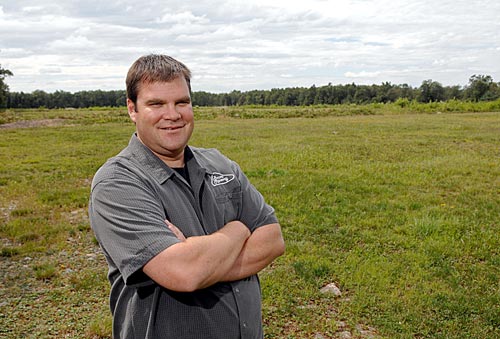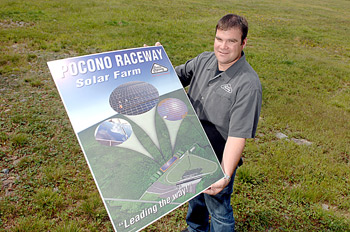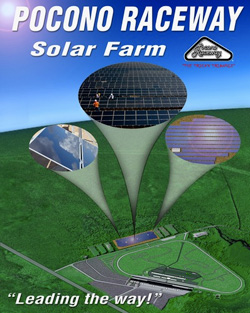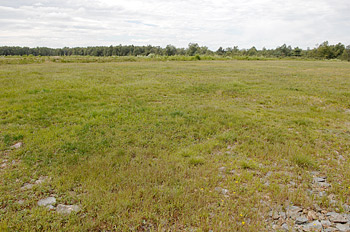 Pocono Raceway, one of NASCAR’s most unique and largest venues, is going big again.
Pocono Raceway, one of NASCAR’s most unique and largest venues, is going big again.
Faced with rising energy bills, the raceway plans to build the world’s largest solar energy project by any sports facility.
About 40,000 photovoltaic panels will produce three megawatts of power once the project is completed by spring, 2010, Pocono Raceway president Brandon Igdalsky says. The solar panels will be erected on a 25-acre lot adjacent to the track and will power the 2.5-mile triangular-shaped speedway, the village of Pocono, the Blakeslee Inn and the campground.
 “Last year we started getting letters from PP&L regarding degregulation and our bills going up,” Igdalsky says. “So we started looking at what are we going to do? We started looking at every option.”
“Last year we started getting letters from PP&L regarding degregulation and our bills going up,” Igdalsky says. “So we started looking at what are we going to do? We started looking at every option.”
Pocono Raceway was notified that its energy bill could top $500,000 annually, a 40 percent increase, and officials were worried that power bills would continue to climb out of control. The cost of the solar farm is estimated between $15-$17 million. Igdalsky says the project could pay for itself in 10 years.
The Northeast Pennsylvania track hosts two NASCAR Sprint Cup races each year–one in June and another in August–bringing more than 100,000 fans per race to the Poconos and surrounding areas. A 2005 study revealed the Sprint Cup races and the track’s lease program yields an economic impact that exceeds $360 million annually.
Pocono Raceway’s location brings fans from New York City and Philadelphia (about 90 miles from each city), a factor that has kept the track as one of a select few sites on NASCAR’s schedule to host two events each season.
 This first-of-its-kind solar project, especially if it is successful, should strengthen Pocono’s grip on maintaining two races each year. That’s good news for local businesses that depend on the fans and income the raceway brings to the area.
This first-of-its-kind solar project, especially if it is successful, should strengthen Pocono’s grip on maintaining two races each year. That’s good news for local businesses that depend on the fans and income the raceway brings to the area.
Igdalsky and his staff explored the use of wind power, too, but concerns over endangered birds were an issue. To raceway officials, the obvious choice for alternative energy was solar power. They considered using rooftops to house the panels, but the weight-bearing needs of the buildings on site were a concern.
Then Igdalsky had a conversation with raceway owner Joseph “Doc” Mattioli, who had another suggestion.
“When we had all of the information we thought we needed we went to Doc and he says, ‘We’re not using those parking lots across the street, so why don’t we just use those?'” Igdalsky says. “At that point we had one of those moments like this was going to be cool because now we could do a lot more.”
The raceway is embarking on a stadium project never seen before. In the U.S., baseball stadiums AT&T Park, home of the San Francisco Giants and Progressive Field, home of the Cleveland Indians, use solar power, but Pocono Raceway’s projected three megawatts of energy is reportedly the largest output. Pocono’s solar farm is expected to produce enough energy that it will sell unused power back to PJM Interconnection.
 Igdalsky says the track is not only building for today, it’s securing its future.
Igdalsky says the track is not only building for today, it’s securing its future.
“Go big or go home, that was the mentality going into this,” Igdalsky says. “We wanted to do something that was going to power what we need and with the village growing, eventually we’re going to need this power anyway. Why not do the maximum we can do now? We can always add onto it later.”
The solar farm, which is being constructed by enXco and overseen by developer Evolution Energies, will be up and running for the spring, 2010 NASCAR race at Pocono. Also, once the project is complete, the track will invite local high schools to come in and tour the facility, nestled in a rural setting within the Pocono Mountain School District, and learn about how the solar panels capture the sun’s rays and produce energy.
“We’re doing something really good for the environment,” Igdalsky says. “I’m from the generation that we have to do something to fix what our great-great-great grandparents started with the industrial revolution. It’s time for us now to fix it and go a different route. For me, it’s a personal thing to do my part for the environment.”
Mike Kuhns is a freelance writer based in the Poconos, where he enjoys hunting, Rudy’s Tavern, and covering local sports and happenings. Send feedback here.
To receive Keystone Edge free every week, click here.
Photos:
Brandon Igdalsky, Pocono raceway president
All photographs by Jason Farmer
